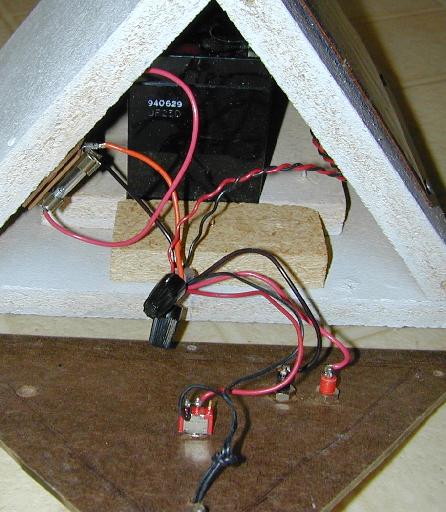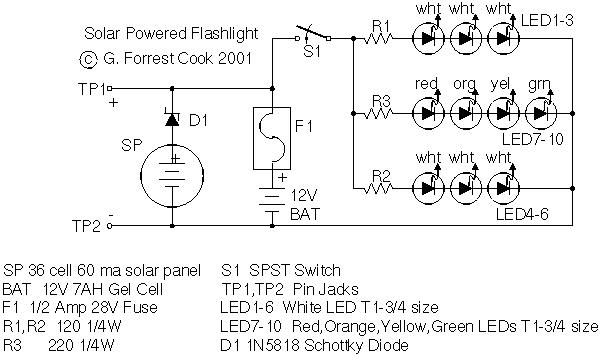


Introduction
Tired of always spending money on flashlight batteries only to have them fail just when you need them? Try this simple circuit out. It would make an excellent science fair project. The white LEDs are quite bright, they provide enough light to illuminate a small room at night. The LEDs produce a nicely focused beam. You can read by the light of this device. The box also doubles as a 12V power source and can run other small loads such as a transistor radio. This project was built with theSimpler is Better approach, the materials are common and many substitutions are possible.
Specifications
- Operating Voltage: 11-12.8V DC
- Solar Charging Current: 60ma approx.
- LED Lamp Operating Current: 60ma approx.
Theory
The solar panel puts out about 60ma of current, this is enough
to float-charge the 12V gell cell without overcharging. With this
limited amount of current, a charge controller is not required.
Other batteries may be used such as smaller lead acid batteries or
NiCd cells (use 10 in series), but overcharging and leaking battery
goo may result if you exceed the battery charge ratings. A smaller,
lighter 3.5 Amp Hour lead acid battery would probably work
perfectly, but the price is the same as a 7 Amp Hour battery so I
chose the latter. There are 3 series strings of LEDs in this
circuit, the resistors limit the current through the LEDs and
prevent them from burning up. The white LEDs have a higher voltage
drop and only 3 can be used in series with a 12V (11-13V) source.
The red/orange/yellow LEDs have a lower voltage drop per diode, so
4 can be wired in series. The colored LEDs are optional but tend to
add a warmer color to the light. White LEDs are expensive, if you
are on a budget, try building the light with just one of the three
LED strings shown. One could certainly adapt this basic circuit to
work on a lower voltage such as 6V, the LED resistors would need to
be changed to maintain a 20ma current through each string and a
lower voltage solar panel could be used. 
Construction
Most of the effort went into building the box, any shape will do, but I built this unit so that the battery just fit inside and the solar panel is mounted at approximately 45 degrees from horizontal. I used particle board and wood screws to hold the box together, other materials will be more rain proof. White gloss paint was applied to give the particle board some protection from rain and keep the box cool in the sun. The LED mounting system is somewhat fragile but allows the light to be rotated up and down. The cylinder is made from an unthreaded spacer with a 4-40 screw hole tapped in the middle for connecting the LED circuit board. The C mount is just a piece of flat aluminum that I bent in a vise, hammered into shape, trimmed with a pair of tin snips, and filed smooth. The white diffuser around the LEDs is a cap from a juice bottle that shields the intense white light from the side. The LED circuit board was custom built with press-n-peel film but can easily be built with a piece of perforated board or prototype PCB material. The resistors are mounted on the circuit board, along with the LEDs. Don’t overheat the LED wires when soldering, white LEDs are expensive and LEDs in general can be destroyed by over heating. When soldering, clip a heat sink to the LED leads. All wiring was done with stranded #22 gauge wire and wire nuts. Note that the specified solar panel comes with its own built in diode, that will work fine, but a 1N5818 schottky diode in parallel with the existing diode will give slightly more charging current due to a lower voltage drop.
Use
Turn off the LED switch and point the solar panel at the sun in the morning, adjust the panel towards the sun a few times a day, or simply point the panel in the direction of the sun at noon. The battery will charge. Turn the light on at night, it should run for many hours. The box will maintain a charge if it is left in a sunny spot indoors. One full day of charging should be enough for several nights of light. The pin jacks can be used to occasionally check the battery voltage, under sunlight the voltage rises up to about 12.8V and at night, it should not be allowed to go below 11V or the battery life will be shortened. A new, fully charged battery will run the light for around 100 hours, so if you put the box in the sun during the day, total discharge should not be a big problem. Experimenters will want to measure the current in and out of the battery, this can be done by inserting an ammeter in series with the fuse and the battery. Other 12V loads can be powered by this system, just plug them into the pin jacks or better, add a polarized output connector. I have been using this device for several years now, it just keeps on working and working.
Parts
- 1x 12V 7AH sealed lead acid battery, Panasonic LC-R127R2P or Yuasa NP7-12, from DigiKey
- 1x GM-684 12V 60ma solar panel, p/n 08SLC09 from Elecronix Express
- 1x red LED, T1-3/4 size
- 1x orange LED, T1-3/4 size
- 1x yellow LED, T1-3/4 size
- 1x green LED, T1-3/4 size
- 6x white LEDs, T1-3/4 size from Jameco
- 2x 120 ohm 1/4 W resistors
- 1x 220 ohm 1/4 W resistor
- 1x 1/2 Amp 28VDC fuse
- 1x fuse holder
- 2x crimp on battery clips
- 3x wire nuts
- 1x 1N5818 diode
- 1x spst toggle switch
- 2x pin jacks
- 1x box large enough to fit the battery and solar panel.
- misc hardware
Sources
- Forrest Cook http://www.solorb.com/elect/